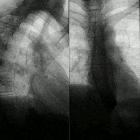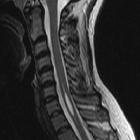leprosy
Leprosy, previously known as Hansen's disease, is a chronic infectious disease caused by Mycobacterium leprae and presents mainly in tropical developing countries.
Epidemiology
It is most common in tropical developing countries and is endemic in over 100 countries. Worldwide, there is a prevalence of 3 per 100,000 people . A progressive decline in prevalence rates has been observed worldwide, owing to multi-drug treatment .
Clinical presentation
There is a long incubation period of ~3 years (range: 6 months-20 years) between infection and onset of multi-systemic symptoms and signs :
- cutaneous erythematous plaques
- peripheral lower limb edema
- mixed peripheral neuropathy (often with resultant injuries) +/- hypoesthesia/paresthesia +/- neuralgia
- peripheral nerve thickening, which may be palpable
- corneal ulcers
- saddle-nose deformity , leonine facies
Pathology
Mycobacterium leprae attacks the skin and peripheral nerves and has a predilection for the cooler appendages of the body with characteristic involvement of the small bones of the hands and feet.
Bone lesions in patients with leprosy are usually due to trauma and secondary bacterial infection superimposed on denervated tissues.
Bone lesions due to direct leprous infection are unusual, varying from 3-5% in one series, and these lesions exhibit radiologic findings of acute and chronic osteomyelitis similar to those of other granulomatous infectious agents.
Radiographic features
The radiologic findings are similar to those caused by other conditions in which sensory impairment is complicated by traumatic injury and infection (Charcot joint).
Motor denervation due to leprous infection of peripheral nerves contributes to deformities such as claw hand and claw toes and is sometimes associated with the development of concentric bone atrophy.
Absorption of bone in leprosy manifests as a decrease in bone length and width and results in a tapered appearance at the end of the bone, which has been likened to a licked candy stick.
When complicated by repeated microtrauma, secondary bacterial infection, or both, digits may be resorbed.
Treatment and prognosis
- multidrug therapy: dapsone, clofazimine and rifampin
- monotherapy is no longer used; The World Health Organization recommends 6 and 12-month regimens for paucibacillary and multibacillary disease, respectively
- prognosis: good in early and mild cases; advanced cases (nerve damage and tissue deformity) are irreversible
History and etymology
It was named after Gerhard Armauer Hansen, a Norwegian physician who identified the bacillus Mycobacterium leprae as the cause of the disease in 1873 .
Differential diagnosis
The differential for musculoskeletal changes is largely that of other causes of a Charcot joint and tissue loss, including:
- diabetes mellitus
- frostbite
- pernicious anemia
- scleroderma
- syringomyelia
- tabes dorsalis
- familial sensory neuropathy
Siehe auch:
und weiter:

 Assoziationen und Differentialdiagnosen zu Lepra:
Assoziationen und Differentialdiagnosen zu Lepra:



